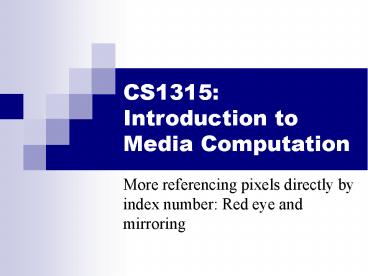CS1315: Introduction to Media Computation - PowerPoint PPT Presentation
Title:
CS1315: Introduction to Media Computation
Description:
Removing Red Eye. def removeRedEye(pic, startX, startY, ... Find pixels close to red, then replace them with a new color replacementColor. Why use a range? ... – PowerPoint PPT presentation
Number of Views:97
Avg rating:3.0/5.0
Title: CS1315: Introduction to Media Computation
1
CS1315 Introduction to Media Computation
- More referencing pixels directly by index number
Red eye and mirroring
2
Removing Red Eye
- When the flash of the camera catches the eye just
right (especially with light colored eyes), we
get bounce back from the back of the retina. - This results in red eye
- We can replace the red with a color of our
choosing. - First, we figure out where the eyes are (x,y)
using MediaTools
3
Removing Red Eye
- def removeRedEye(pic, startX, startY, endX, endY,
replacementColor) - red makeColor(255,0,0)
- for x in range(startX, endX)
- for y in range(startY, endY)
- currentPixel getPixel(pic, x, y)
- if (distance(red, getColor(currentPixel)) lt
165) - setColor(currentPixel, replacementColor)
Why use a range? Because we dont want to replace
her red dress!
- What were doing here
- Within the rectangle of pixels (startX, startY)
to (endX, endY) - Find pixels close to red, then replace them with
a new color replacementColor
4
Fixing it Changing red to black
- removeRedEye(jenny, 109, 91, 202, 107,
makeColor(0,0,0)) - Jennys eyes are actually not black
- could fix that
- Eye are also not mono-color
- A better function would handlegradations of red
and replacewith gradations of the correcteye
color
Lets try it! Whos got red eyes?
5
If you know where the pixels are Mirroring
- Imagine a mirror horizontally across the
picture,or vertically - What would we see?
- How do generate that digitally?
- We simply copy the colors of pixels from one
place to another
6
Mirroring a picture
- Slicing a picture down the middle and sticking a
mirror on the slice - Do it by using a loop to measure a difference
- The index variable is actually measuring distance
from the mirrorpoint - Then reference to either side of the mirrorpoint
using the difference
7
Recipe for mirroring
def mirrorVertical(source) mirrorpoint
int(getWidth(source) / 2) for y in range(1,
getHeight(source)) for xOffset in range(1,
mirrorpoint) pright getPixel(source,
xOffset mirrorpoint, y) pleft
getPixel(source, mirrorpoint - xOffset, y)
c getColor(pleft) setColor(pright, c)
8
How does it work?
- Compute the half-way horizontal index
- The y value travels the height of the picture
- The xOffset value is an offset
- Its not actually an index
- Its the amount to add or subtract
- We copy the color at mirrorpoint-offset to
mirrorpointoffset
def mirrorVertical(source) mirrorpoint
int(getWidth(source) / 2) for y in range(1,
getHeight(source)) for xOffset in range(1,
mirrorpoint) pright getPixel(source,
xOffset mirrorpoint, y) pleft
getPixel(source, mirrorpoint - xOffset, y)
c getColor(pleft) setColor(pright, c)
9
Can we do this with a horizontal mirror?
def mirrorHorizontal(source) mirrorpoint
int(getHeight(source) / 2) for yOffset in
range(1, mirrorpoint) for x in range(1,
getWidth(source)) pbottom
getPixel(source, x, yOffset mirrorpoint)
ptop getPixel(source, x , mirrorpoint -
yOffset) setColor(pbottom, getColor(ptop))
10
Of course!
11
What if we wanted to copy bottom to top?
- Very simple Swap the order of pixels in the
bottom line
def mirrorHorizontal(source) mirrorpoint
int(getHeight(source) / 2) for yOffset in
range(1, mirrorpoint) for x in range(1,
getWidth(source)) pbottom
getPixel(source, x, yOffset mirrorpoint)
ptop getPixel(source, x , mirrorpoint -
yOffset) setColor(ptop, getColor(pbottom))
Set color this way, instead of this
setColor(pbottom, getColor(ptop))
12
Messing with Santa some more
13
Doing something useful with mirroring
- Mirroring can be used to create interesting
effects, but it can also be used to create
realistic effects. - Consider this image that M.G. took on a trip to
Athens, Greece. - Can we repair the temple by mirroring the
complete part onto the broken part?
14
Figuring out where to mirror
- Use MediaTools to find the mirror point and the
range that we want to copy
15
Writing functions for specific filesgenerally
- The function to mirror the temple needs to work
for one and only one file. - But we still dont want to write out the whole
path. - setMediaPath() allows us to pick a directory
where our media will be stored. - getMediaPath(filename) will generate the entire
path for us to the filename in the media
directory - THIS ONLY WORKS WHEN WERE ACCESSING FILES IN THE
MEDIA DIRECTORY AND WHERE WE HAVE SET THE PATH
FIRST!
16
Program to mirror the temple
- def mirrorTemple()
- source makePicture(getMediaPath("temple.jpg"))
- mirrorpoint 277
- lengthToCopy mirrorpoint - 14
- for x in range(1, lengthToCopy)
- for y in range(28, 98)
- p1 getPixel(source, mirrorpoint - x, y)
- p2 getPixel(source, mirrorpoint x, y)
- setColor(p2, getColor(p1))
- show(source)
- return source
17
Did it really work?
- It clearly did the mirroring, but that doesnt
create a 100 realistic image. - Check out the shadows Which direction is the sun
coming from?































